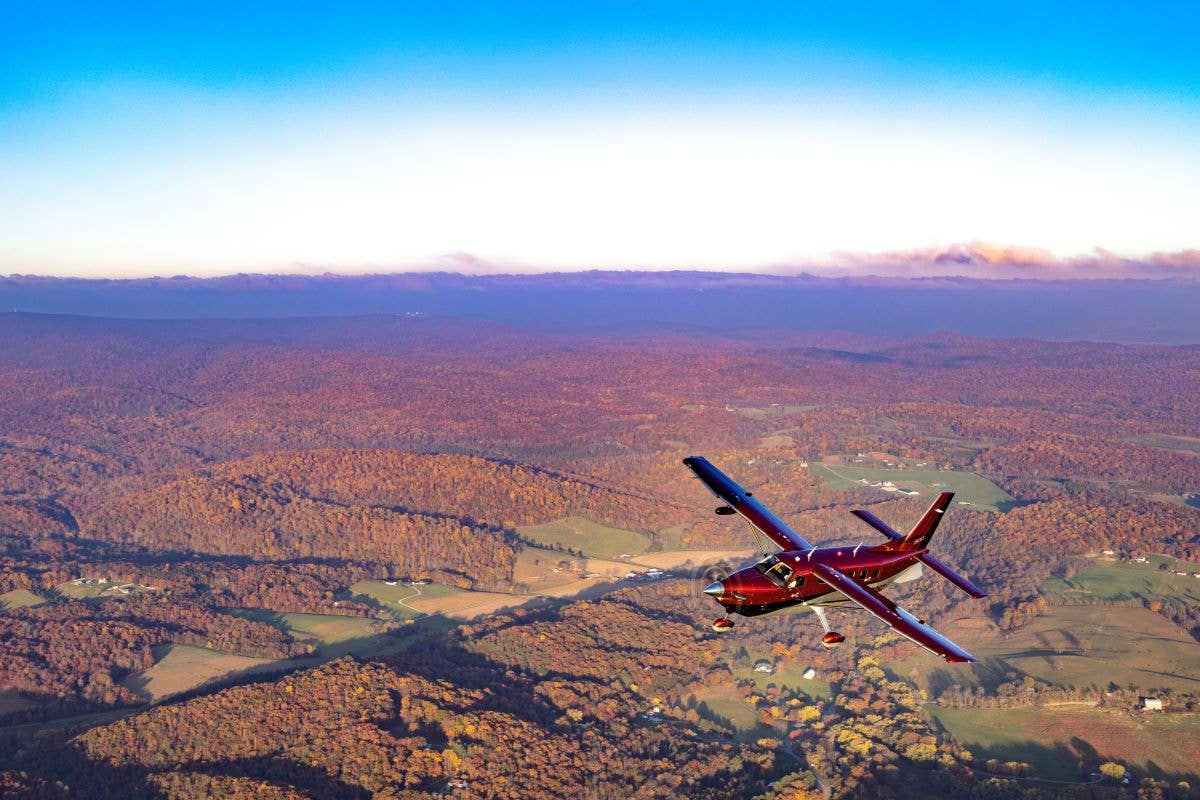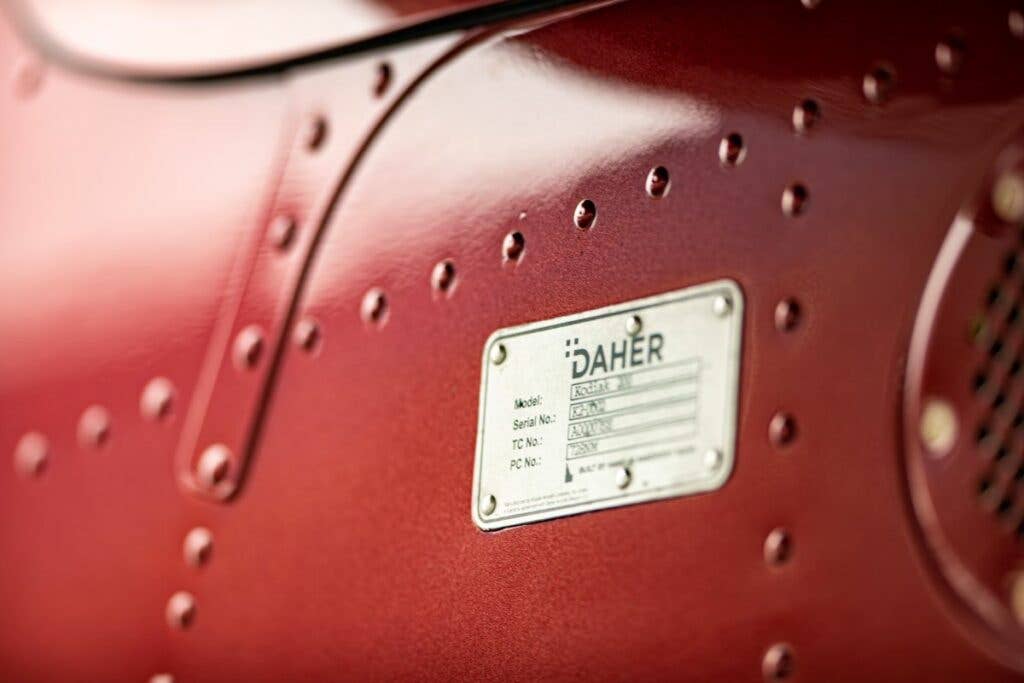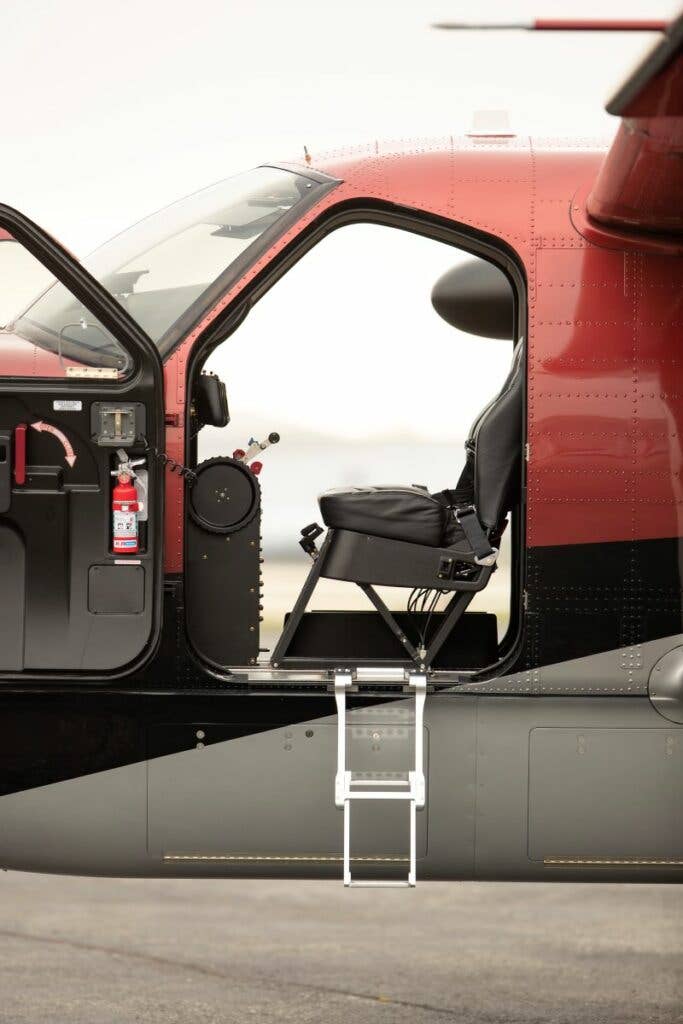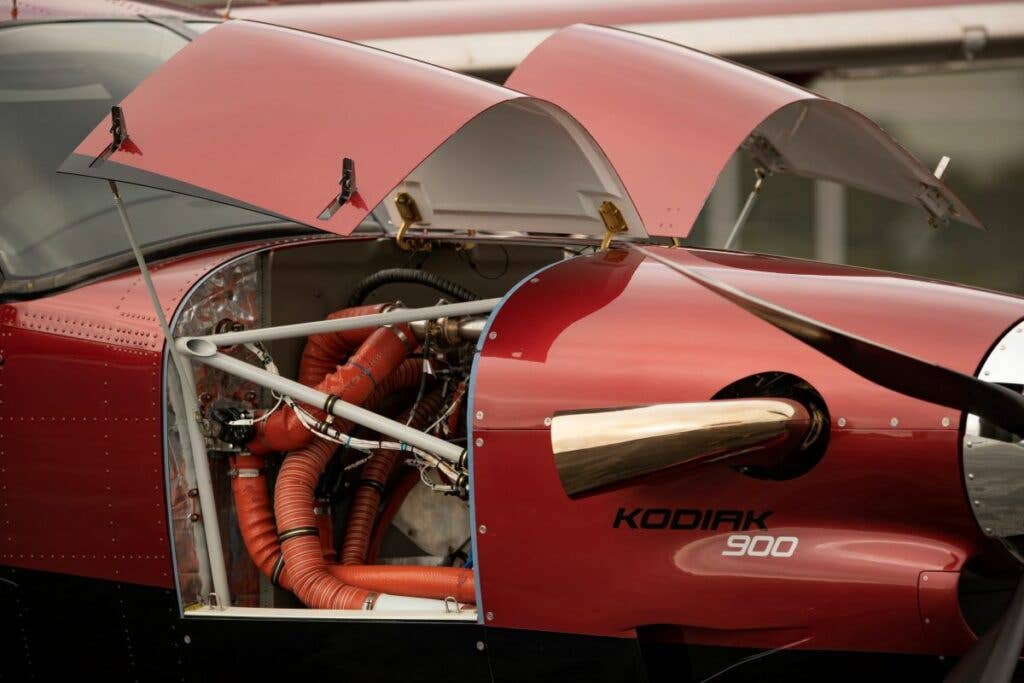We Fly: Daher Kodiak 900
A lot more of everything—speed, space, and style—that gives Kodiaks their great reputation in the backcountry.

Daher Kodiak 900 [Credit: Jim Barrett]
What compels us to fly, to load up an airplane and strike out for adventure? It’s not just the call of the places we long to fly to, but also the confidence inspired by having a machine matched to the task. One that takes us—and our closest companions and their gear—further and faster and into those special places.
There’s a visual pleasure to an airplane that’s wellmade, too. The effective translation of function into form makes a considerable impression when you approach a well-designed aircraft on the ramp, for one. There’s also the exterior design, enhanced by the choice of paint scheme—and the paint itself.
Looking at the Daher Kodiak 900 as I prepared for my demo flight, I couldn’t help but think “frosted cranberries,” though the trade name for the Sherwin-Williams paint color is the more prosaic Red Pearl.
If you're not already a subscriber, what are you waiting for? Subscribe today to get the issue as soon as it is released in either Print or Digital formats.
Subscribe NowMaybe it was the lead-up to the Halloween and Thanksgiving holidays that gave me that sensation when I walked up to it on the ramp at Hagerstown Municipal Airport (KHGR).
We’d assembled to shoot the cover of this issue, with the maples and beeches throwing an embroidered coverlet of russets, golds, and greens over the hillsides, still shivering off their leaves for the season in western Maryland.
The rich, blazing red glazed over an executive gray dash and set off against that backdrop in a herald. But there was so much more to the monster turboprop than just the 900’s significant ramp presence. The exterior hinted at a lot more, inside and out.
A. The Garmin G1000 NXi incorporates envelope protection, along with data from the GTS 800 TAS and WX 500 Stormscope in the executive package.
B. The integrated GFC 700 autopilot uses a relocated control panel to the top center of the flight deck.
C. Upgrades to flooring combat issues stemming from trapped condensation in the 100.
D. The oxygen system facilitates high-country operations as well as long-distance cruise so that the pilot can optimize speed at altitudes that stretch the turboprop’s range even farther.
E. The power quadrant and central pedestal remains virtually the same as the 100, easing the transition between the models.
First Impression
It is a big baby. The top of the tail sits nearly 17 inches taller than the 100's, though both the forward and aft door sills are roughly the same height off the ground. The 900’s door handle solves a minor yet common nag from pilots—you have to reset the lever flush on the outside of the door on the 100 in order for it to close properly from the inside. No longer is that the case on the 900—the handle resets itself. Redesigned steps in the rear cargo door make entry more like the TBM, too.
As Mark Brown, Daher’s chief demo pilot for the Kodiak, taxied into the wide ramp at Hagerstown for our day’s festivities, we stood a bit transfixed by its approach. Though I’d visited the airplane on display at shows twice, you don’t feel the 900’s true size until you see it in the wild—and taxiing towards you.
We conducted a detailed walkaround, in which Brown outlined all of the key points of difference between the models, as well as those critical elements that remained the same—the wing, the tail, and the cargo pod now smoothed into the massive cowling.
The preflight revealed all of the mods that have translated into 25-plus knots of additional speed for this model over its sibling—the wing flap track fairings, the integrated cowl faired into the belly of the fuselage, and the wheel pants spring to mind first. The cowl shrouds a critical part of the equation, as the obvious streamlining you see from the outside only tells part of the story.
Firewall forward, the 900 is completely new. The increased speed results from a few different areas, with the Pratt & Whitney PT6A-140A at 900 hp continuous—from which the model draws its name—on take-off and in cruise, connected to the Hartzell five-bladed composite prop, it wrests more power throughout the phases of flight while making gains in other areas. “Noise was also a big component,” and a reason to upgrade to the new prop, said Brown. “Specifically being owned by Daher in Europe—noise is a much bigger deal, although we wanted to be good neighbors everywhere.”
Other factors in the 900’s increased speed lie in the inlet and outlet design. “What a lot of people underestimate is how much drag is produced by airflow as it goes into the engine and as it goes through coolers, and when it exits,” said Brown, adding that, on exit, you want that airflow to be smooth. If it’s turbulent, that creates drag.
Customer feedback—from 15 years in the field—drove several standard features, such as single-point refueling (an option on the 100) and an improved TKS ice protection system. The reservoir location under the cockpit, accessed through the forward section of the cargo pod on the 100, created a pain point from both a pilot’s and ops’ perspective. The new location makes it easy to inspect fluid levels and service the reservoir.
Once on board, the sense of presence couples with the same practical ruggedness reproduced from the100’s flight deck. The power quadrant carries over from the original model, as does the circuit breaker panel placement. The avionics and aux bus switches have been updated from rockers to toggle switches as well.
Up front, the Garmin G1000 NXi provides the interface for all aircraft control, navigation, and engine management in three displays. This is coupled with a G5 electronic flight instrument with an internal battery backup. The NXi suite provides familiar grounds for transitioning pilots, whether they are moving from the 100, across the Daher fleet from a TBM, or from a glass-equipped piston single or twin. The GFC 700 autoflight system’s mode controller moved from below the central MFD to above it, for slightly better access.
Climb Power
Power management changes subtly as the 900 drives through the air behind the new PT6A-140A—the largest PT6 variant yet. Daher elected to flat rate the -140A as it has the PT6As in the TBM line—and the PT6E-66XT in the 960—restraining the horses to 900 shp. The benefit? You still command a 150-hp increase over the -34in the 100, and you have access to that same hp over the entire operational range, up to 99 degrees Fahrenheit ambient temperature. The powerplant carries a 4,000-hour TBO and on-condition hot section requirement.
Our engine start generally follows the same sequence as in the 100, with a couple of tweaks. The starter switch no longer has Lo/Motor and Hi positions for start-up, and the igniters come on automatically when the start switch is moved to the On position and the aux fuel pump is On, moving to Standby after a successful light off. The pilot monitors Ng (the rotation speed of the compressor section of the engine) as it comes up quickly through 12 percent before introducing fuel to low idle. Then they monitor fuel flow and ITT (staying below 1,090 degrees) until Ng climbs past 62 percent, when the starter can be released. After bringing the generator and alternator online and making electrical system checks, the prop lever comes out of feather to max rpm.
As we watch everything stabilize, we call for a taxi clearance and head out to Runway 7. This wide expanse of pavement really isn’t necessary—except for its ability to accommodate my roll-in of right rudder as I push up the PT6A to full bore, gauging its strength.
Slow Flight, Short-Field Ops
We climbed to 10,500 feet to test climb and cruise. Because the 900 is unpressurized—like the 100—you may pick an altitude that keeps you out of the oxygen masks. The fastest speeds are to be found up higher—without the wing-mounted radar pod—but we consistently saw speeds above 205 ktas after we’d leveled off.



Good low-speed handling characteristics turn the dark edge of the envelope into a playground—and that’s exactly where the Kodiak needs to bring its best game. In the backcountry environment, the margin of safety this provides becomes critical—not just at STOL strips in the Idaho wilderness but remote places scattered around the globe where a minor screw-up can send you into a starring role in a Lord of the Flies tale.
The 900 carries over the multi-phased wing, with a series of primary airfoil and leading edge cuffs that drive stall propagation inboard to retain aileron effectiveness. Brown demonstrated this directly with our stall series. I set up for a standard power-off stall, no flaps, and watched it break cleanly. Then he said, "check this out," and proceeded to take the 900 deep into stall territory like we were in a 1,500-pound Cessna 150 as opposed to an 8,000-pound utility hauler.
The safety benefit produced by advanced aerodynamics, like those in the original Kodiak’s wing, carry over into the 900. The natural low-airspeed protection of the wing offered a buffer against the variances introduced by pilots and micro conditions on final approach. Again, this is invaluable in the true backcountry where you do not have the support of a planned airfield and normal TERPS and airport design criteria. Also, the tail cone on the 900 is virtually identical to the 100, including the empennage—more commonality that is intended to help the model fit well on the production line with its sibling.
The new design also allowed engineers to move the landing gear out of the belly of the airplane. That change resulted in reducing complexity in the flight control system too—a lot of pulleys that had to route cables up and around the forward cabin were eliminated to a good extent, according to Brown. To preserve a similar control feel between the 100 and 900 models, Daher for the most part kept control surfaces the same, with minor adjustments made at the higher end of the speed spectrum, for consistency in the transition from low to high speeds. According to Brown, this was accomplished with a few extra springs and similar components.
Halfway through the demo flight, we landed at Bedford County Airport (KHMZ). Though not a short strip by any measure, it provided a more immediate feeling of the airplane’s capabilities. We set up for a short-field takeoff and were easily off in the first quarter of the 5,006-foot-long runway on the mild afternoon (21 degrees C/+8 degrees C ISA).
In cruise, the 900 achieves the desired speed while reigning in fuel burn—thus far it has proven a 9 percent reduction in specific fuel consumption at 205-knot-plus cruise speeds, according to both Brown and Nicolas Chabbert, CEO of Daher Aircraft USA. “I flew from Sandpoint, [Idaho], to take the aircraft to Oshkosh,” said Chabbert in an interview in October. “I actually had nine people on board, and we were nicely truing at 205 knots.” It took them a little less than five hours to cover the roughly 1,200 nm distance."
Daher Kodiak 900
- Price (executive package): $3.487 million
- Engine: Pratt & Whitney PT6A-140A, 900 hp
- TBO: 4,000 hours
- Propeller: Hartzell Raptor 5-blade composite, 97 in.
- Seats: 2+8
- Wingspan: 45 ft.
- Wing area: 240 sq. ft.
- Wing loading: 33.3 lbs./sq. Ft.
- Power loading: 8.89 lb./shp
- Length: 37.7 ft.
- Height: 16.1 ft.
- Cabin height: 4 ft. 9 in.
- Cabin width: 4 ft. 6 in.
- Cargo compartment volume (external): 65 cu. Ft.
- Cargo compartment capacity (external): 680 lb.
- Standard empty weight: 4,470 lb.
- Max takeoff weight: 8,000 lb.
- Max landing weight: 7,800 lb.
- Standard useful load: 3,630 lb.
- Full fuel payload: 1,546 lb.
- Fuel: 311 gal. usable
- Max rate of climb, sea level: 1,724 fpm
- Certified ceiling: 25,000 ft.
- Stall speed (flaps extended): 65 kcas
- Max cruise speed: 210 ktas, at 12,000 ft.
- Max cruise range/endurance: 969 nm. 4.3 hours at 58 gph
- Takeoff distance, sea level (ground roll): 1,015 ft.
- Takeoff distance, sea level (ground roll, no reverse): 1,460 ft
More on the Inside
A black leather interior says “utility” but also “let’s do this in style.” The aim to create an environment like the inside of a Range Rover, yet to keep much of the field serviceability for which the Kodiak is rightfully famous, is apparent.
The interior can be configured in a multiplicity of ways, up to two seats up front and eight in the back.Only the left front seat—the pilot’s perch—is required for flight. Though you need to comply with the seat pitch limits outlined in the POH’s section six, weight and balance, there’s a lot of flexibility baked into the way you can lay out the cabin for your particular operations—or any given mission. Like its predeces-sor, the 900 can hold all the seats on board in the vast belly-slung cargo compartment that is now a seamless part of the fuselage.
Other considerations carry over from the earlier Kodiak design, such as nose-gear tow points that are functionally the same as those on a Cessna 182 or 206 for commonality on the FBO ramp—or for getting it into your own hangar.
As a whole, the 900 looks like it has hit that bluespace in the sky—as our next section reveals—that first Quest and now Daher have targeted so precisely
This article was originally published in the February 2023 Issue 934 of FLYING.

Subscribe to Our Newsletter
Get the latest FLYING stories delivered directly to your inbox







